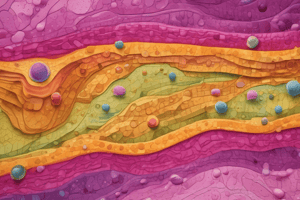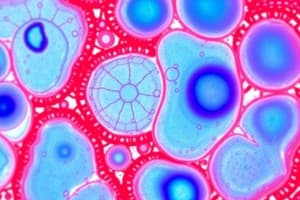Podcast
Questions and Answers
What is the primary function of simple cuboidal epithelium?
What is the primary function of simple cuboidal epithelium?
- Protection
- Secretion and absorption (correct)
- Sensation
- Transportation
Ciliated simple columnar epithelium is found only in the respiratory tract.
Ciliated simple columnar epithelium is found only in the respiratory tract.
False (B)
What are the cells that secrete mucus in the intestines called?
What are the cells that secrete mucus in the intestines called?
Goblet cells
The epithelium lining the heart and blood vessels is known as __________.
The epithelium lining the heart and blood vessels is known as __________.
Which of the following is NOT a function of simple columnar epithelium?
Which of the following is NOT a function of simple columnar epithelium?
Match the types of epithelial tissues with their functions:
Match the types of epithelial tissues with their functions:
Simple cuboidal epithelium can be found in the kidneys.
Simple cuboidal epithelium can be found in the kidneys.
What structures increase the surface area of simple columnar epithelial cells in the small intestine?
What structures increase the surface area of simple columnar epithelial cells in the small intestine?
Which type of epithelium is primarily specialized for absorption or filtration?
Which type of epithelium is primarily specialized for absorption or filtration?
Stratified epithelium consists of a single layer of cells.
Stratified epithelium consists of a single layer of cells.
What type of cells gives pseudostratified epithelium its multilayered appearance?
What type of cells gives pseudostratified epithelium its multilayered appearance?
Simple cuboidal epithelium is usually _________ shaped in cross-section.
Simple cuboidal epithelium is usually _________ shaped in cross-section.
Match the following cell types with their shapes:
Match the following cell types with their shapes:
Which type of epithelium is found in areas that experience a lot of wear and tear?
Which type of epithelium is found in areas that experience a lot of wear and tear?
Transitional epithelium can change shape depending on the degree of distension.
Transitional epithelium can change shape depending on the degree of distension.
Where is simple squamous epithelium typically found in the body?
Where is simple squamous epithelium typically found in the body?
What is the primary function of stratified epithelium?
What is the primary function of stratified epithelium?
All types of stratified epithelium contain at least one layer of flat cells.
All types of stratified epithelium contain at least one layer of flat cells.
What type of epithelium is found in the lining of the mouth and esophagus?
What type of epithelium is found in the lining of the mouth and esophagus?
The outer layer of the skin consists of __________ stratified squamous epithelium.
The outer layer of the skin consists of __________ stratified squamous epithelium.
Match the following types of stratified epithelium with their respective locations or functions:
Match the following types of stratified epithelium with their respective locations or functions:
Which of the following types of cells can be found in the deeper layers of stratified squamous epithelium?
Which of the following types of cells can be found in the deeper layers of stratified squamous epithelium?
Transitional epithelium is able to stretch without breaking cell connections.
Transitional epithelium is able to stretch without breaking cell connections.
What distinguishes transitional epithelium from nonkeratinized stratified squamous epithelium?
What distinguishes transitional epithelium from nonkeratinized stratified squamous epithelium?
Flashcards
Basement Membrane
Basement Membrane
A thin extracellular layer separating the epithelium and connective tissue.
Simple Epithelium
Simple Epithelium
A type of epithelium with a single layer of cells, often found in areas with minimal wear and tear, specialized for absorption or filtration.
Stratified Epithelium
Stratified Epithelium
A type of epithelium with at least two cell layers, found in areas with high wear and tear.
Pseudostratified Epithelium
Pseudostratified Epithelium
Signup and view all the flashcards
Squamous Cells
Squamous Cells
Signup and view all the flashcards
Cuboidal Cells
Cuboidal Cells
Signup and view all the flashcards
Columnar Cells
Columnar Cells
Signup and view all the flashcards
Transitional Cells
Transitional Cells
Signup and view all the flashcards
Simple Squamous Epithelium
Simple Squamous Epithelium
Signup and view all the flashcards
Stratified Epithelium
Stratified Epithelium
Signup and view all the flashcards
Stratified Squamous Epithelium
Stratified Squamous Epithelium
Signup and view all the flashcards
Nonkeratinized Stratified Squamous Epithelium
Nonkeratinized Stratified Squamous Epithelium
Signup and view all the flashcards
Keratinized Stratified Squamous Epithelium
Keratinized Stratified Squamous Epithelium
Signup and view all the flashcards
Stratified Cuboidal Epithelium
Stratified Cuboidal Epithelium
Signup and view all the flashcards
Stratified Columnar Epithelium
Stratified Columnar Epithelium
Signup and view all the flashcards
Transitional Epithelium
Transitional Epithelium
Signup and view all the flashcards
Simple Cuboidal Epithelium
Simple Cuboidal Epithelium
Signup and view all the flashcards
Simple Columnar Epithelium
Simple Columnar Epithelium
Signup and view all the flashcards
Modified Columnar Cells
Modified Columnar Cells
Signup and view all the flashcards
Microvilli
Microvilli
Signup and view all the flashcards
Goblet Cells
Goblet Cells
Signup and view all the flashcards
Study Notes
Basement Membrane
- A thin extracellular layer separates the epithelium and connective tissue
- This layer is called the basement membrane
Epithelium Categories
- Covering and lining epithelium is classified based on location and function
- Simple epithelium is found in areas with minimal wear and tear, specialized for absorption or filtration
- Stratified epithelium is found in areas with high wear and tear
- Pseudostratified epithelium has a single layer of cells, but some cells don't reach the surface giving a multilayered appearance
- Pseudostratified cells secrete mucus or contain cilia to move mucus and foreign particles
Epithelium Cell Shapes
- Squamous cells are flat, scale-like, and attached like a mosaic
- Cuboidal cells are cube-shaped in cross-section, sometimes appearing as hexagons
- Columnar cells are tall and cylindrical, appearing as rectangles set on end
- Transitional cells have a combination of shapes, found where there is a high degree of distension or expansion
- Transitional cells can range from cuboidal to squamous in different layers, depending on how much they are pulled out of shape
Simple Epithelium
- Consists of a single layer of cells
- Types: squamous, cuboidal, columnar
Stratified Epithelium
- Consists of at least two cell layers
- Types: squamous, cuboidal, columnar, transitional
Pseudostratified Epithelium
- Has a single layer of cells but appears stratified
Simple Squamous Epithelium
- Single layer of flat, scale-like cells
- Adapted for diffusion, osmosis, and filtration
- Found in the air sacs of lungs, kidney filtering areas, inner surfaces of the ear
Stratified Epithelium
- More durable than simple epithelium, protecting underlying tissues from wear and tear
Stratified Squamous Epithelium
- Cells in superficial layers are flat, while deep layers vary in shape
- Basal cells continually multiply pushing surface cells outward
- Surface cells become dehydrated, shrink, and harden
Nonkeratinized Stratified Squamous Epithelium
- Found on wet surfaces exposed to wear and tear
- Examples: lining of the mouth, tongue, esophagus, vagina
Keratinized Stratified Squamous Epithelium
- Surface cells are modified into a tough layer containing keratin (a protein resistant to water and friction)
- Found in the outer layer of skin
Stratified Cuboidal Epithelium
- Relatively uncommon
- Found in ducts of sweat glands, fornix of the conjunctiva, cavernous urethra, pharynx, epiglottis
- Primarily for protection
Stratified Columnar Epithelium
- Basal layer consists of shortened, irregularly polyhedral cells
- Superficial cells are columnar
- Functions in protection and secretion
- Found in parts of the male urethra, larger excretory ducts, anal mucous membrane
Transitional Epithelium
- Similar to nonkeratinized stratified squamous epithelium
- Outer layer cells are large and rounded, allowing stretching without breaking
- Lines the bladder and urethra
- When stretched, cells become squamous-like
Simple Cuboidal Epithelium
- Cells have a central nucleus
- Functions in secretion and absorption
- Found in: surface of ovaries, lens capsule, pigmented epithelium of the retina, kidney tubules, smaller glands
Simple Columnar Epithelium
- Nuclei located near the base of the cells
- Can be ciliated or nonciliated
- Nonciliated type lines the digestive tract, excretory ducts, and gallbladder
- Ciliated type lines upper respiratory tract, uterine tubes, uterus, paranasal sinuses, central canal of the spinal cord
Modified Columnar Cells
- Luminal surfaces can be modified based on location and function
- In the digestive tract, cells protect underlying tissues and aid in food-related activities
- Microvilli: increase surface area for absorption of nutrients and fluids in the small intestine
- Goblet cells: secrete mucus as a lubricant in the digestive tract
Studying That Suits You
Use AI to generate personalized quizzes and flashcards to suit your learning preferences.
Related Documents
Description
This quiz covers the structure and classification of epithelial tissues, including the basement membrane and various cell shapes. Test your understanding of different epithelial types and their functions in the human body.




